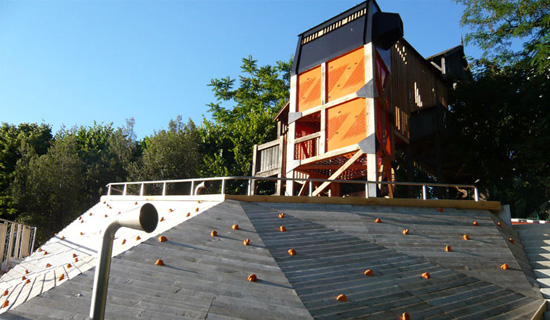|
|
|
|---|
Monday, April 26, 2010

For those inured to the paranoia of modern-day (American) parenting, this playground, designed by BASE for Belleville Park in Paris' 20th arrondissement, must seem utterly baffling. Where there should be springy rubber matting and wood chips, there's bare concrete. The timber pylons look to be no more than a forest of sharp edges and pointy corners awaiting an arm to fracture, a nose to bleed and a forehead to dent. Though not that steep, the climbing walls seem to be screaming to be equipped with ropes, harnesses and helmets.
To our childless eyes, however, it looks like a proper playground, a neo-eugenics landscape in which society births strapping young citizens. Here, in simulated sieges of an abstract castle perched atop vertiginous cliff faces and fortified with obstructions, doughy, networked children are scarred into physical and mental fitness, into unlikely future burdens on the social health infrastructure of the country.


While this €1.1 million, high-end design playground isn't nearly anarchic and scruffy, nevertheless, it calls to mind Carl Theodor Sorensen's concept of the junk playground, renamed for England as adventure playground. Mostly built on bombed-out sites during postwar reconstruction, these playgrounds consisted of “all sorts of old scrap that the children [...] could be allowed to work with, as the children in the countryside and in the suburbs already have. There could be branches and waste from tree polling and bushes, old cardboard boxes, planks and boards, 'dead' cars, old tyres and lots of other things, which would be a joy for healthy boys [and girls?] to use for something.” What children do with all the junk will depend on their imagination, initiative, their cooperation with other children and their autonomy from parental control.
“The adventure playground,” wrote John Bertelsen, the first supervisor at the first such playground (1943), at the Emdrup housing estates in Copenhagen, “is an attempt to give the city child a substitute for the play and development potential it has lost as the city has become a place where there is no space for the child's imagination and play. Access to all building sites is forbidden to unauthorized persons, there are no trees where the children can climb and play Tarzan. The railway station grounds and the common, where they used to be able to fight great battles and have strange adventures, do not exist any more. No! It is now not easy to be a child in the city when you feel the urge to be a caveman or a bushman".




Wetground
Labels: playgrounds